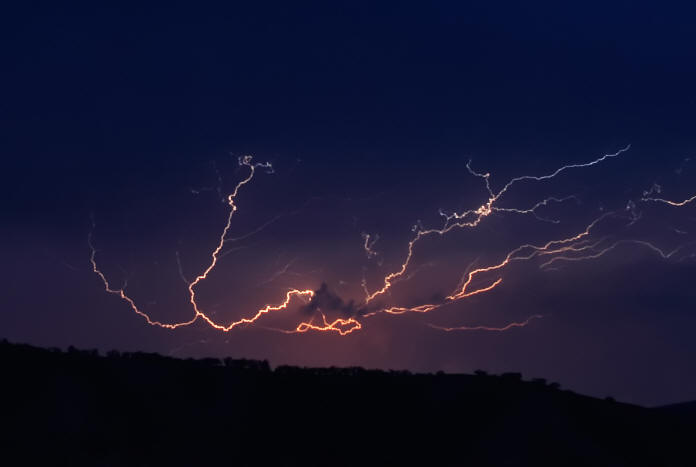|
|
Lightning, Sticky Tape, and
Black Hole Observations -
Part 1
Aug 04, 2009
There is
an endless supply of astronomical
and astrophysical reports with
“surprising” findings. However, the
observations fit within the Electric
Universe paradigm.
A recent
report in October 2008 concerns
the close correlation of X-ray and
optical light emissions from two
black hole candidates: GX 339-4 and
Swift J1753.5-0127. Each system is
theorized to have a black hole in
orbit around a normal star. This
report describes how these systems
were observed in X-ray and optical
light at the same time. The surprise
was that the optical light and X-ray
emissions were closely synchronized
to each other and obviously coupled
to a common physical cause.
This observation completely
contradicts current theory which
predicts that X-ray and optical
emissions result from entirely
different mechanisms in these black
hole binaries. What we’ll show below
is that the synchronized X-ray and
optical emissions, both in their
nature and timing, correspond very
well to what we now know about
terrestrial lightning as well as
plasma arcs at even smaller scales.
Let’s break down this analysis by
looking at the black hole binary
systems in question, understanding
the data and observations,
discussing briefly some relatively
new things we’ve learned about
terrestrial lightning and other
electrical arc phenomena, and then
seeing how it all ties together.
GX 339-4 was first discovered in
1973 and is considered a black hole
candidate (BHC) due to its X-ray
emission patterns (which, following
circular reasoning, were similar to
other BHC’s). GX 339-4 is a binary
system where the black hole is
thought to orbit its dim companion
star about once every 1.7 days. The
optical counterpart was only
discovered in
1982 when it flared very
brightly at the time.
Swift J1753.5-0127 is also theorized
to be a candidate for a black hole
simply because of its X-ray
emissions. It was discovered in 2005
when a particularly violent X-ray
outburst was picked up by the Swift
Burst Alert Telescope in 2005. In
July 2008, Zurita et al.
determined that the BHC orbits
around what is likely a main
sequence star with an orbital period
of 3.2 hours. Again, it is a
“transient X-ray” black hole binary
with an optical counterpart.
It is important to note that no one
has observed a black hole. There’s
an X-ray source that’s been mapped
to a location in the sky. Everything
else: black holes, accretion disks,
that’s all interpretation. Ignore
the artist’s conception in the
report for a moment and
understand what is really being
observed here.
There’s an X-ray bright spot that
flickers in X-ray wavelengths, and
that is assumed to be a black hole
with an accretion disk (because that
was assumed in another paper by
someone else). As it happens,
there’s an optical counterpart
(something seen in the same location
in the sky in visible wavelength)
for this X-ray source. So we see a
bright spot in optical and we see a
bright spot in X-ray. These bright
spots “shimmer” in X-ray and optical
light in about the same place in the
night sky. So be careful with these
artist’s conceptions of accretion
disks and so on. No one has seen
that.
Both systems are believed to be two
bodies separated by a few million
kilometers. That is very close, well
within Mercury’s orbit relative to
the Sun for example. Theory dictates
that the X-rays originate in an
accretion disk formed around the
black hole fed by heated matter
pulled out of the optical
counterpart (a star like our sun).
The optical light is thought to be a
secondary product of X-rays
energizing the surrounding gases.
However, the findings completely
rule out that model. The
investigative lead, Poshak Gandhi,
states, "Instead the variations in
the X-ray and visible light output
must have some common origin, and
one very close to the black hole
itself."
In the original
report on GX 339-4, Ghandi et
al. show that, over their nights of
observation, the optical peak lagged
the X-ray peaks by about 150 ms. The
authors in their discussion begin to
hypothesize about reconnecting
magnetic field lines, dense
magnetized blobs falling towards the
black hole, etc. I won’t get into
“reconnecting magnetic field lines”
and the physical implausibility of
that idea. However, there are other
sources on this website that discuss
that particular fiction in some
detail.
Similar cross-correlation between
the timing of the X-ray and optical
emissions were also noted for
Swift J1753.5-0127. In this case
there was an optical dip that
preceded the X-ray peak followed by
a weak optical peak. In another
report on X-ray transient XTE
J1118-480, Kanbach et al. (2001)
found that the optical peak lagged
the X-ray peak by about 0.5 seconds
with an odd “precognition blip”
before the X-ray. Durant et al.
state at the end of their article
that “....there exists a causal link
between the optical emission and the
X-ray emission.” I would like to
propose that this causal link is
probably something a lot like
lightning.
To be continued.
Contributed by Thomas Wilson

Tom Wilson has a PhD in cell biology
but for the last 16 years has been
posing as an Electrical Engineer in
the semiconductor industry.
|
|
|
|
|
|
SPECIAL NOTE - **New Volumes Available:
We are pleased to announce a new
e-book series
THE UNIVERSE ELECTRIC. Available now, the first volume
of this series, titled Big Bang, summarizes the failure of modern cosmology
and offers a new electrical perspective on the cosmos. At
over 200 pages, and
designed for broadest public appeal, it combines spectacular
full-color graphics with lean and readily understandable
text.
**Then second and third volumes in the series are now available,
respectively titled Sun and Comet, they offer
the reader easy to understand explanations of how and why these bodies
exist within an Electric Universe.
High school and college students--and teachers in
numerous fields--will love these books. So will a large
audience of general readers.
Visitors to the Thunderbolts.info site have often
wondered whether they could fully appreciate the Electric
Universe without further formal education. The answer is
given by these exquisitely designed books. Readers from
virtually all backgrounds and education levels will find them
easy to comprehend, from start to finish.
For the Thunderbolts Project, this series is a milestone.
Please see for yourself by checking out the new
Thunderbolts Project website, our leading edge in
reaching new markets globally.
Please visit our
Forum
|
|
|
|
|
|
|
|








